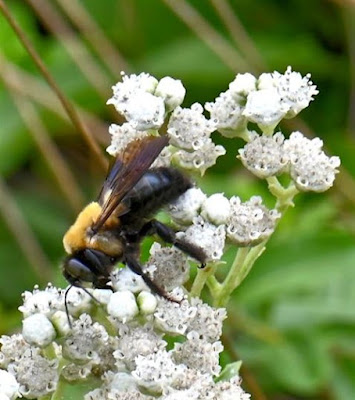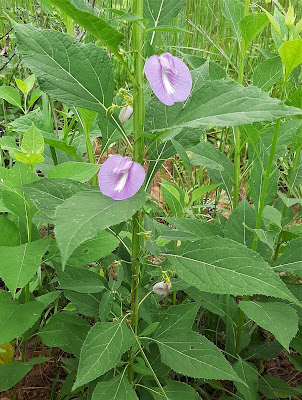Online Show & Tell for the week of Aug 20 - 24, 2022
Reminder: there is no Ramble on August 25. We will resume meeting at the Children's Garden Arbor on September 1 at 9:00am, as usual.
Many
thanks to the ramblers who sent in photos and stories for this week's
Online Show & Tell! Keep sending your stories to LCHAFIN@UGA.EDU and
put "Show & Tell" in the subject line so I can keep track of them. The last Online Show & Tell will be posted August 31.
Gary Crider offered this week's reading as a perfect follow-up to the Great Georgia Pollinator Census last weekend.
Valediction
by Charles W. Pratt
Now the bumbling bees that hover
Over loveliness in flower
Important with their store of pollen
Have had their hour;
Time has come for you to shed your
Silken petals and declare
Whether you are apple, cherry,
Plum or pear,
And all summer take your pleasure
Nourishing the ripening fruit
With the sun and rain you welcome
Through leaf, through root.
Rosemary Woodel sent a wonderful video she made at Wesley Woods Athens in July 2022, entitled "Flight -- Birds, Flies, Bees, Wasps, Butterflies and Moths." Rosemary and her compatriots at WWA created a Connect to Protect Garden, planting
native plants and pollinator-friendly flowers. The results are stunning! Click here to watch the 12 minute video. Here's a still snipped from her video of a Hummingbird Clearwing Moth visiting a verbena flower cluster.
Thank you, Rosemary!
************************************************************
This week just happened to include the Great Georgia Pollinator Census. Nature Ramblers were there!
Don Hunter sent in these photos and accompanying narrative about his GGPC adventures...
2022 Great Georgia Pollinator Census, My Madison County Adventures
I had been really looking forward to this year's Great Georgia Pollinator Census so I was quite happy when the weather turned out more favorable than expected. I was able to go out right after lunch on Friday and do two counts in the Wild Quinine in a power line right-of-way at the end of our street. On Saturday, I headed over to the large Georgia Power right-of-way I have "adopted" to count the pollinators at five different flowering native plants.
DAY
ONE - GGPC
 |
| Wild Quinine (Parthenium integrifolium) with Carpenter Bee |
I chose to count insects on Wild Quinine because it is a reliable pollinator magnet, drawing in a variety of flies, wasps, bees, and other insects and bugs. I stopped by to check it out on the 17th and there was a lot of activity, so I was confident it would be a good location for the count. As it turned out, at the two locations where I counted, I counted a single carpenter bee, quite a few small bees, mainly halictid bees, and several species of wasps. Here are a few pics from the Wild Quinine:
 |
|
Noble Scoliid Wasp, center, and a furrow/halictid bee, upper left, on Wild Quinine |
 |
|
Norton's Alkalai Bee/Norton's Nomia, a large sweat bee, on Wild Quinine |
DAY TWO - GGPC
On day two, I drove over to the miracle acre beneath the big Georgia Power power line in southern Madison County. This is proving to be, perhaps, a relic prairie from the earlier days when prairies were more commonplace in our neck of the woods. Linda and I have identified over 60 species of native plants here, excluding the trees and grasses. There's a lot of blooming going on now so it was a natural for a counting location. I counted at five different plant species, Southern Mountain Mint (X2), Greater Tickseed, Roundleaf Boneset, Woodland Sunflower, and Kidneyleaf Rosinweed. I saw mostly wasps, small bees, and butterflies, with a few flies and other critters. Here are a few photos from day two, with a story or two.
 |
Great Golden Digger Wasp on Southern Mountain Mint |
My first census location was at a large, bushy Southern Mountain Mint. I found a place and sat down to lower my profile, and enjoyed a very pleasant 15 minutes of counting, starting off with this Great Golden Digger Wasp. How lucky I was! As I stood up to move on, I looked at where I was just sitting and saw fire ants boiling all over the place. I looked around on my legs and pants and only found a few of the ants and started waiting for the biting to begin. I never got the first bite. All I can figure is that one of my butt cheeks must have been planted directly over the mound entrance, blocking their exit. On a related note, two years ago, during the 2020 census, I had just gotten five minutes into one of my counts when I noticed the unmistakable sensation of fire ants biting my ankles and shins. Not one wanting to waste a count, I stood my ground, enduring the bites, which probably numbered in the twenties or thirties, until the fifteen minutes were up. I then bailed off to a safe locations to pull of my shoes and socks and remove any remaining ants.
 |
| Eastern Tiger Swallowtail on Southern Mountain Mint |
My original intentions were to count and photograph the swallowtails at a large patch of Joe-Pye Weed across the road from the "miracle acre," but this was not to be. When I was at the location just a day earlier, the swallowtails were swarming a ditch full of Joe Pye Weed. When I arrived today, I was met with this sight:
 |
| Former Joe-Pye Weed patch, now a mown right-of-way |
A bee fly showdown was underway when I arrived at this Greater Tickseed (Coreopsis major) flower head (below). I've been seeing the Geron sp. flies for the past several years, but the Exoprosopa is a new species for me. Katherine has also seen this larger species in her yard in the past several days.
%20tip%20of%20upper%20petal,%20and%20larger%20bee%20fly,%20Exoprosopa%20brevirostris%20on%20Coreopsis%20majo.jpg) |
| Small bee fly (Geron sp.) on the tip of upper ray flower, and a larger bee fly, Exoprosopa brevirostris, nectaring on disk flowers. |
 |
|
A lovely Horace's Duskywing on Greater Tickseed.
There were quite a few of these around. |
 |
| Beautiful Golden-reined Digger Wasp on Southern Mountain Mint |
Looking forward to my fifth year of counting in 2023!
Thank you, Don!
************************************************************************
From Roger and Betsey Collins who have rambled Alaska the
past three weeks:
We have enjoyed being in a Maritime Rainforest ecology. High temperature is usually 55. Just want to share a couple of items.
%20near%20Anchorage.jpg) |
| I was wearing my blue Ramblers t-shirt the day I climbed Flat Top Mountain (3,510 feet elevation) near Anchorage. |
 |
| One morning a pair of Sand Hill Cranes came by our front door. While related to the cranes that migrate over Georgia, these guys will be flying back to California and Mexico. |
Thank you, Roger and Betsey!
*************************************************************
From Cynthia Beane
 |
| My sweet dog Henry has a nose for finding box turtles in our woods. Look closely under the leaves and you can see her shell. So far we have located a male and a female living in our small forest. |
Not too far away from the Carolina Lily, I found a small field of Yellow Fringed Orchid, Platanthera ciliaris. There is also a smaller population of these fringed orchids in North Carolina's Stone Mountain State Park. The Stone Mountain orchids were found growing in an open power line field.
 |
| Note from Linda: It is a mystery to me why this species is named Yellow Fringed Orchid when it is clearly orange. By whatever name, it is a highlight of the mountains in August. |
Thanks, Cynthia!
***********************************************************************
Emily recommends this article from the Washington Post: "Want to see how climate change is stressing bees? Look at their wings." Thanks, Emily!
***********************************************************************
Dale recommends this "In Defense of Plants" podcast about native azalea pollination by way of swallowtail wings. Look for episode 376, featuring the researcher Mary Jane Epps who discovered the phenomena of wing pollination in Flame Azalea pollination. Almost all of the hundreds of podcasts "In Defense of Plants" are interesting.
Further recommendation by Dale: a PBS Nature video (Season 36, episode 12) with remarkable footage
of butterflies: "Sex, Lies, and Butterflies." The story of the wing-pollinated azalea begins at minute 16 and lasts about 4 minutes, but the whole video is fascinating with gorgeous photography. If you were about skeptical wing-pollination, seeing the strands
of sticky pollen being pulled from anthers may convince you. You can also view the program here.
Thank you, Dale!
*****************************************
Identifying Perilla can be tricky. Perilla will always have the typical mint family traits of a square stem, opposite leaves, and aromatic leaves, in this case a distinctive, basil-like smell. But there's a lot of variation in the height of mature plants, anywhere from 5 inches to 5 feet. And the leaf margins can vary from merely toothed to almost frilly and may be purple-ish or just plain green.
 |
| Perilla patch along the new ADA Trail in the powerline right-of-way at the Botanical Garden. These plants were 4 feet tall before treatment. |
 |
| Perilla patch after treatment with a mix of hand-pulling and herbicide |
Perilla patch soon after spraying with a low concentration of Triclopyr. This herbicide is specific to broad-leaf plants and does not affect grasses or needle-leaved conifers. A few minutes of spraying wiped out thousands of these plants. Triclopyr is not harmful to animals and does not persist in the environment.
Thanks, Gary!
**********************************************************
Note from Linda: there's been a lot of talk on my neighborhood listserve lately about what to do with rescued wild animals. Here's a suggestion from a neighbor that might be of interest: "The Atlanta Wild Animal Rescue Effort (AWARE) is a wonderful organization at Arabia Mountain (near Atlanta). They will take injured or abandoned wildlife and try to save and restore the animal to good health to be released back into its natural habitat."
**********************************************************
Linda has been doing some late summer botanizing around the county. Here are a few mostly terrible photos to prove it.
 |
| Sparkleberry (Vaccinium arboreum) leaves with a fungal gall called Fly-speck Leaf Spot, Ophiodothella vaccinii. I identified this gall using Gallformers.org, thanks to Bill Sheehan's class a few weeks ago. |
 |
| Chalk Maple (Acer leucoderme) fruits |
 |
| Flowering Dogwood (Cornus florida) fruits – and leaves that seem to have given their all to support biodiversity |
 |
| Butterfly Pea (Centrosema virginianum) tightly twined around a Wingstem plant |
 |
| Elephant's Foot (Elephantopus tomentosus) |
 |
| Flowering Spurge (Euphorbia corollata) |
 |
| Low St. John's-wort (Hypericum stragulum) |
 |
| Pencil Flower (Stylosanthes biflora) |
 |
| Arrow-arum (Peltandra virginica) growing with False Nettle and Lizard's Tail in the Middle Oconee River floodplain |
 |
| False Nettle (Boehmeria cylindrica) with the last of this year's flowers |
 |
| Lizard's Tail (Saururus cernuus) with pale, long, narrow fruit clusters |










